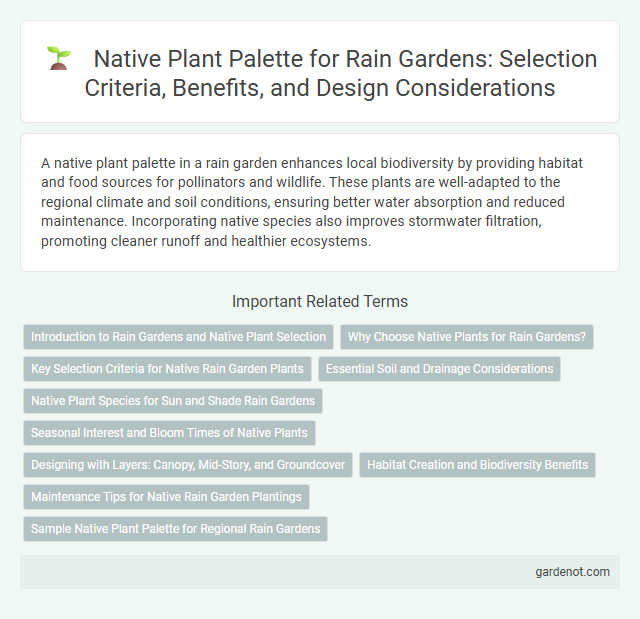A native plant palette in a rain garden enhances local biodiversity by providing habitat and food sources for pollinators and wildlife. These plants are well-adapted to the regional climate and soil conditions, ensuring better water absorption and reduced maintenance. Incorporating native species also improves stormwater filtration, promoting cleaner runoff and healthier ecosystems.
Introduction to Rain Gardens and Native Plant Selection
Rain gardens utilize native plant palettes to enhance stormwater management by promoting natural infiltration and reducing runoff. Selecting native species ensures plants are well-adapted to local soil, climate, and hydrology, increasing garden resilience and supporting regional biodiversity. Key native plants for rain gardens include sedges, switchgrass, and blue flag iris, which thrive in wet conditions while providing habitat for pollinators.
Why Choose Native Plants for Rain Gardens?
Native plants in rain gardens enhance water absorption and reduce runoff by adapting to local soil and climate conditions, improving overall garden resilience. Their deep root systems filter pollutants effectively, promoting cleaner groundwater and healthier ecosystems. Choosing native species supports local biodiversity, providing habitat for pollinators and wildlife essential to ecological balance.
Key Selection Criteria for Native Rain Garden Plants
Selecting native rain garden plants involves prioritizing species adapted to local climate, soil types, and hydrological conditions for optimal water absorption and filtration. Key criteria include deep root systems for soil stabilization, tolerance to both wet and dry cycles, and native biodiversity support to attract pollinators and wildlife. Emphasizing plants with seasonal interest and low maintenance contributes to sustainable rain garden performance and ecosystem resilience.
Essential Soil and Drainage Considerations
Selecting a native plant palette for rain gardens requires understanding essential soil and drainage considerations to ensure plant health and stormwater management efficiency. Soils should be well-draining yet capable of retaining moisture long enough to support native species such as sedges, rushes, and wildflowers adapted to periodic inundation and dry spells. Proper grading and soil amendments, including organic matter to enhance infiltration rates, optimize the rain garden's ability to reduce runoff, filter pollutants, and promote biodiversity.
Native Plant Species for Sun and Shade Rain Gardens
A native plant palette for rain gardens includes key species adapted to local sun and shade conditions, ensuring optimal growth and ecological benefits. Sun-loving native plants such as Black-eyed Susan (Rudbeckia hirta) and Switchgrass (Panicum virgatum) thrive in well-lit rain gardens, enhancing pollinator support and soil stabilization. Shade-tolerant natives like Christmas fern (Polystichum acrostichoides) and Wild ginger (Asarum canadense) improve moisture retention and biodiversity in shaded rain garden areas.
Seasonal Interest and Bloom Times of Native Plants
A carefully selected native plant palette for rain gardens maximizes seasonal interest by including species with staggered bloom times from early spring through late fall. For instance, red columbine (Aquilegia canadensis) blooms in spring, while purple coneflower (Echinacea purpurea) peaks in mid-summer, and goldenrod (Solidago spp.) adds vibrant fall color. Incorporating a variety of native grasses and perennials ensures dynamic visual appeal and supports local pollinators year-round.
Designing with Layers: Canopy, Mid-Story, and Groundcover
Designing a rain garden with a native plant palette involves layering canopy trees like red maples (Acer rubrum), mid-story shrubs such as spicebush (Lindera benzoin), and groundcovers including wild ginger (Asarum canadense), which together enhance stormwater absorption and support local biodiversity. Each layer plays a critical role in maximizing water infiltration, providing habitat for pollinators, and improving soil health through root diversity. This stratified approach mimics natural ecosystems, promoting resilience and reducing maintenance requirements for sustainable rain garden performance.
Habitat Creation and Biodiversity Benefits
Selecting a native plant palette for rain gardens enhances habitat creation by providing essential food and shelter for local wildlife, including pollinators, birds, and beneficial insects. These native species promote biodiversity benefits by supporting complex ecosystems and improving soil health through natural root structures and nutrient cycling. Incorporating a diverse range of native plants increases resilience against pests and environmental stresses, fostering sustainable and thriving habitats.
Maintenance Tips for Native Rain Garden Plantings
Native rain garden plantings thrive with deep watering during establishment, reducing watering frequency as roots mature to promote drought resilience. Regular pruning of spent flowers and removal of invasive species prevent overcrowding and support healthy growth. Mulching with organic material conserves moisture, moderates soil temperature, and suppresses weeds for optimal plant health.
Sample Native Plant Palette for Regional Rain Gardens
A sample native plant palette for regional rain gardens includes species such as Carex stricta (tussock sedge), Asclepias tuberosa (butterfly weed), and Eutrochium purpureum (purple Joe-Pye weed), which are adapted to local soil and moisture conditions. These plants improve water infiltration, support pollinators, and enhance habitat biodiversity while stabilizing the soil and filtering pollutants. Selecting native species tailored to the region ensures resilience and maximizes the ecological benefits of rain gardens.
Native plant palette Infographic

 gardenot.com
gardenot.com